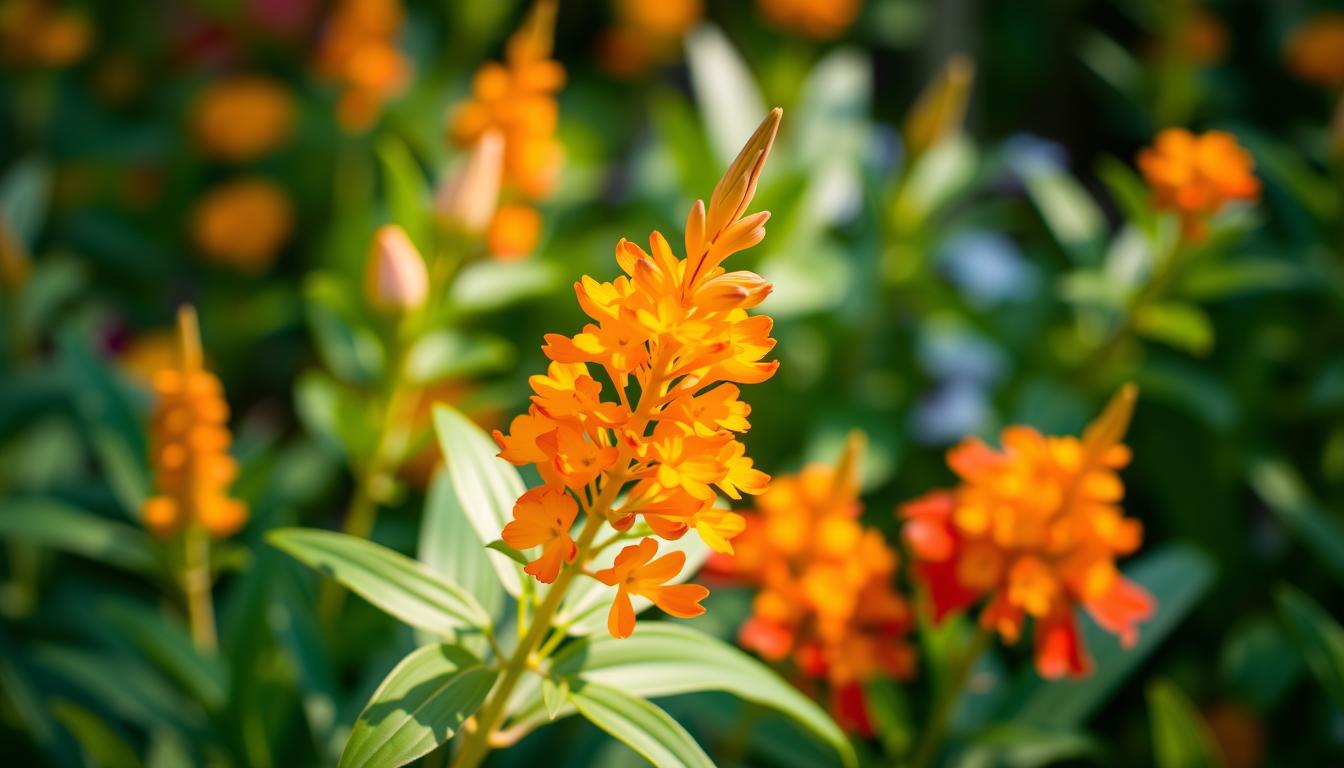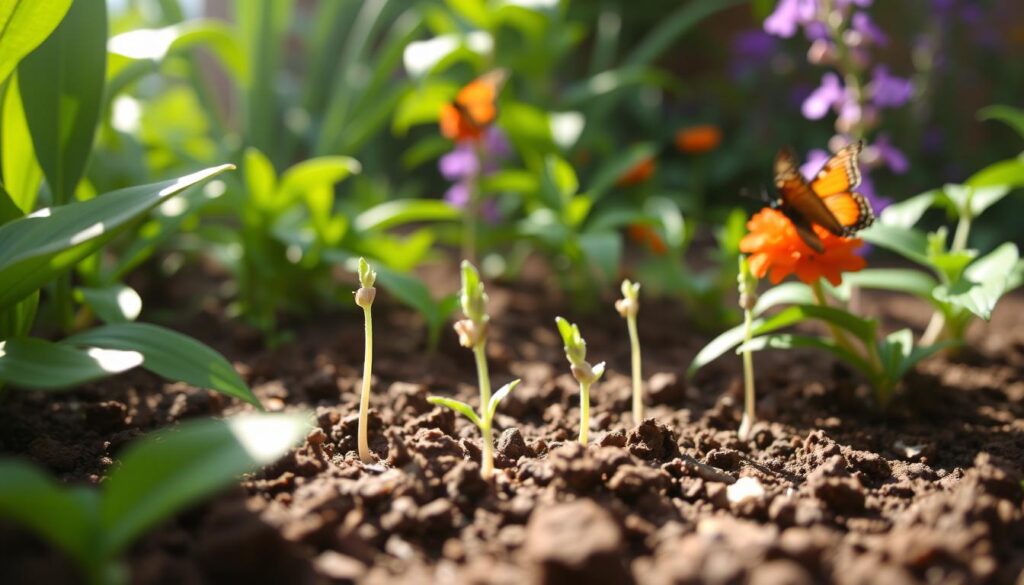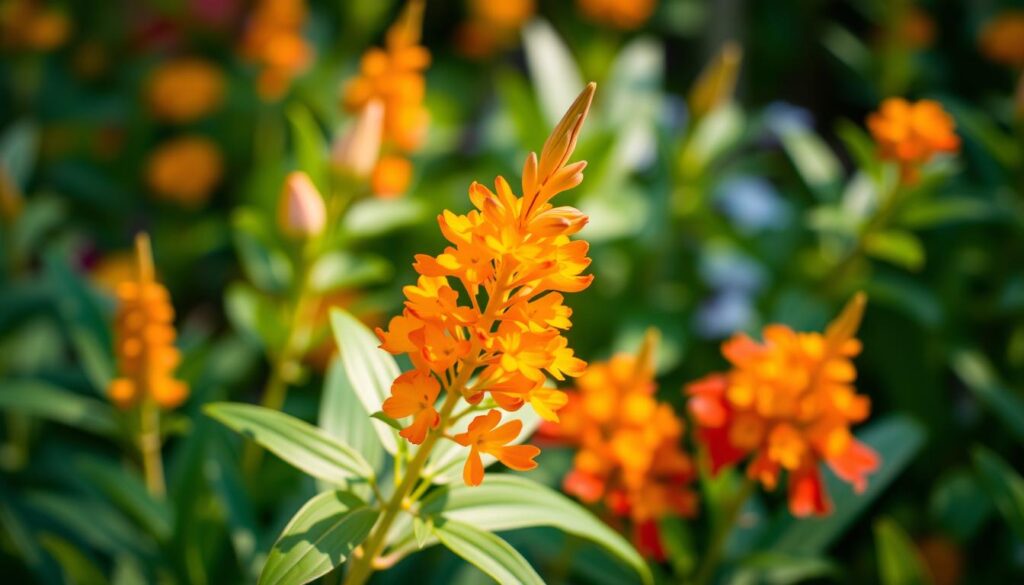I remember the first time I saw the butterfly weed plant (Asclepias tuberosa). Its bright orange flowers looked like a sunset. I knew right then I had to learn more about it. This plant became the heart of my garden, attracting butterflies and showing me the beauty of nature.
In this guide, I’ll share how to grow and care for the butterfly weed plant. You’ll learn about its natural habitat and how to propagate it. This article is for both new and experienced gardeners. It will help you create a beautiful, butterfly-friendly garden.
Key Takeaways
- Butterfly weed (Asclepias tuberosa) is a native perennial that thrives in full sun and well-drained soil.
- This plant is a magnet for butterflies, offering valuable nectar and a host plant for Monarch butterfly larvae.
- Butterfly weed is drought-tolerant and low-maintenance, making it an excellent choice for beginner and experienced gardeners alike.
- Proper planting, propagation, and care techniques are essential for the long-term success of this captivating perennial.
- Incorporating butterfly weed into your garden design can create a stunning visual impact while supporting local ecosystems.
Understanding Butterfly Weed Plant Basics
The orange butterfly weed plant, known as Asclepias tuberosa, is native to North America. It grows well in many places. This plant is famous for its bright flowers that attract many pollinators, like the monarch butterfly.
Native Habitat and Natural Growth Patterns
Butterfly weed grows in the U.S., in places like prairies and meadows. It loves full sun and well-drained soil. It can handle different soils and even drought once it’s settled.
Benefits of Growing Asclepias Tuberosa
The orange butterfly weed plant is more than pretty. It’s a key food for monarch butterfly caterpillars. Its flowers also draw bees, hummingbirds, and other helpful insects.
Plant Characteristics and Features
The butterfly weed plant can grow 2-3 feet tall. It spreads out and has bright, orange flowers all summer. Its green, lance-shaped leaves add to its beauty. Plus, it’s a perennial, coming back every year with the right care.
Ideal Growing Conditions for Butterfly Weed Plant
Choosing the right spot for your butterfly weed plants is key to their success. These vibrant flowers do best in areas with the right sunlight, soil, and climate. Let’s look at the best place to grow your butterfly weed plant.
Sunlight Requirements
Butterfly weed loves the sun. They need full sun exposure, getting at least 6 hours of direct sunlight daily. A sunny spot will help them bloom brightly and abundantly.
Soil Preferences
Butterfly weed plants like well-drained, sandy, or gravelly soil. They can handle different soil pH levels but do best in slightly acidic to neutral soils. Adding compost or organic matter to your soil can help create the perfect spot for your butterfly weed plant.
Climate Considerations
- Butterfly weed is hardy in USDA Hardiness Zones 3 to 9, fitting many climates.
- These plants are good at handling drought and hot, dry weather, perfect for warmer areas.
- But they might not do well in very humid or rainy places, preferring drier conditions.
“Butterfly weed thrives in sunny, well-drained areas, making it the perfect addition to any garden that wants to attract these beautiful pollinators.”
By picking the right location with the right sunlight, soil, and climate, your butterfly weed plants will grow strong and healthy. They’ll provide a vibrant home for butterflies and other pollinators.
Planting Guide and Timing
When planting how to plant asclepias tuberosa, also known as butterfly weed, timing is key. Let’s look at the best seasons and what to consider.
Spring vs. Fall Planting
Planting in spring or fall is best for growth. Spring, from April to May, uses warm soil and rain for strong roots. Fall, from September to October, lets roots grow before winter.
Spacing Requirements
Space is crucial for asclepias tuberosa. Plant 12 to 18 inches apart for growth and root development.
Soil Preparation Methods
Soil matters for asclepias tuberosa. It likes sandy or loamy soil, slightly acidic. Add compost or aged manure to improve it.
“Butterfly weed is a resilient plant, but it thrives best in the right growing conditions.”
Know the best planting times, spacing, and soil prep for a thriving asclepias tuberosa in your garden.
Propagation Methods and Techniques
Propagating your own butterfly weed (Asclepias tuberosa) plants is rewarding and cost-effective. You can grow them from seed or use vegetative methods. Understanding the needs of this native perennial is crucial. Let’s look at the different ways to grow this beautiful plant.
Growing Butterfly Weed from Seed
One popular method is growing from seed. Butterfly weed seeds need cold stratification to germinate. Sow them in the fall or start indoors in late winter. Cover the seeds lightly and keep the soil moist until they sprout.
- Collect ripe seed pods in the fall and store them in a cool, dry place over the winter.
- Sow the seeds directly into your garden in the fall or start them indoors 6-8 weeks before your last frost date.
- Provide the seeds with a period of cold stratification (4-6 weeks at 40°F) to break dormancy.
- Once germinated, transplant the seedlings into larger containers or your garden, being careful not to disturb the delicate roots.
Vegetative Propagation Methods
Butterfly weed can also be propagated through division and stem cuttings. These methods create new plants that are genetically identical to the parent.
- Division: In early spring or fall, carefully divide the plant’s root system, ensuring each division has at least one shoot and a portion of the taproot. Replant the divisions in well-draining soil.
- Stem Cuttings: Take 4-6 inch stem cuttings from the plant in late spring or early summer. Dip the cut end in a rooting hormone and plant in well-draining potting mix. Keep the cuttings consistently moist until they develop roots.
Patience and attention to detail are crucial when growing butterfly weed. With the right care, you can successfully propagate this native treasure. Enjoy its vibrant blooms for years to come.
Essential Care and Maintenance Tips
Butterfly weed plants, or Asclepias tuberosa, are easy to care for. They do well with the right care and attention. Follow these tips to keep your butterfly weed healthy and blooming.
Watering Schedule
Butterfly weed plants like well-drained soil and can handle drought. Water them often in the first year to keep the soil moist. After that, water only when the soil feels dry, about every week or two. Don’t overwater, as it can cause root rot.
Fertilization Requirements
Butterfly weed plants don’t need much fertilizer. Use a balanced, slow-release fertilizer in early spring, as directed. Don’t use too much nitrogen, as it can make the plant grow too much foliage and not enough flowers.
Pruning Guidelines
Butterfly weed plants need little pruning. Cut back the dead parts in late fall or early spring. Leave a bit of growth to encourage new growth. Don’t prune too much, as it can weaken the plant.
By following these care tips, your butterfly weed plants will thrive. They’ll add vibrant colors to your garden and attract butterflies and other pollinators.
Managing Common Pests and Diseases
Keeping your asclepias or butterfly weed plants healthy is key to their success. These hardy plants are mostly resistant to pests and diseases. But, they can still get sick if not cared for right.
Aphids are a big worry for butterfly weed plants. These tiny insects suck sap and can harm leaves and stems. To fight aphids, use organic soaps or introduce ladybugs to your garden.
- Check your plants often for aphids, like curled or colored leaves.
- Use eco-friendly insecticides on affected spots, but avoid harming good bugs.
- Plant things that attract ladybugs and other aphid fighters.
Fungal diseases like powdery mildew or leaf spot can also harm your plants. They make leaves look bad and hurt the plant’s health. To stop these diseases, plant in well-draining soil and make sure air moves well.
“Proper care and vigilance are key to maintaining healthy, thriving butterfly weed plants in your garden.”
Watch your plants closely, treat with organic fungicides, and improve their growing spots. This way, you can enjoy your plants’ beauty and help pollinators for many years.
Companion Planting and Garden Design
Growing the vibrant orange butterfly weed plant can be enhanced by companion planting and garden design. This approach makes the plant more attractive and draws in pollinators. You can choose the right plants to go with it and place the orange butterfly weed plant in various landscapes.
Best Companion Plants
The orange butterfly weed plant looks great with many plants. These include perennials, annuals, and grasses that like well-drained soil and full sun. Some good choices are:
- Purple coneflowers (Echinacea purpurea)
- Blazing star (Liatris spicata)
- Prairie dropseed (Sporobolus heterolepis)
- Switchgrass (Panicum virgatum)
- Black-eyed Susans (Rudbeckia hirta)
These plants add color and attract pollinators. They make your where to plant a butterfly weed plant garden vibrant and healthy.
Landscape Integration Ideas
The orange butterfly weed plant fits well in many landscapes. It’s great for:
- Naturalized meadows or prairies
- Xeriscape or drought-tolerant gardens
- Pollinator-friendly borders and beds
- Rock gardens or along pathways
By placing theorange butterfly weed plantin these spots, you highlight its beauty. It also adds to your garden’s beauty and ecological value.
Creating Butterfly Gardens
If you want to attract many butterflies, the orange butterfly weed plant is key. Plant it in groups or as the main feature of a butterfly garden. This native plant offers nectar and host plants for many butterflies. Pair it with flowers like purple coneflowers and black-eyed Susans for a colorful, pollinator-friendly spot.
Harvesting and Using Butterfly Weed
The asclepias tuberosa, or butterfly weed plant, is a stunning addition to any garden. It’s also very useful. You can use it for decoration or in traditional herbal remedies.
Harvesting the butterfly weed is easy. The best time is when it’s in full bloom, usually in mid-to-late summer. Be careful not to hurt the roots when you harvest.
- Carefully cut the stems at the base, leaving a few inches of growth to allow for regrowth.
- Gently remove the leaves and flowers, ensuring minimal damage to the plant.
- Dry the harvested materials in a well-ventilated, shaded area to preserve their vibrant colors and properties.
After drying, you can use the butterfly weed in many ways. The flowers are perfect for dried arrangements, adding beauty to any room. The leaves and stems are good for herbal remedies, thanks to their medicinal value.
“Asclepias tuberosa, or butterfly weed, is a versatile and beautiful plant that deserves a place in any garden or herbal remedy collection.”
But, the butterfly weed has latex, which can irritate some people. So, wear gloves and avoid touching your eyes or skin when handling it.
By harvesting and using the butterfly weed wisely, you can enjoy its many benefits. You’ll also help protect this important plant for pollinators.
Conclusion
Growing butterfly weed is rewarding for both the gardener and pollinators. It’s a vibrant perennial that thrives with the right care. You’ll enjoy its stunning blooms every season.
Starting with growing butterfly weed from seed or adding established plants is easy. Remember, is butterfly weed perennial. It’s a great addition to your garden for years to come. Enjoy watching it support pollinators in your area.
Now you know how to add butterfly weed to your garden. It’s perfect for a pollinator-friendly space or your existing garden. Watch the colors and the visitors. Feel good about helping your local ecosystem.



